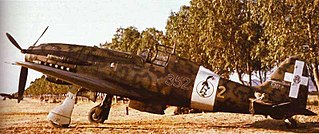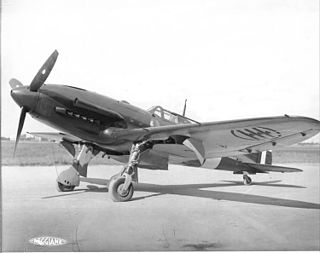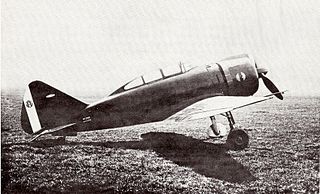
The Macchi C.200 Saetta, or MC.200, was a fighter aircraft developed and manufactured by Aeronautica Macchi in Italy. Various versions were flown by the Regia Aeronautica who used the type throughout the Second World War.

The Macchi C.202 Folgore was an Italian fighter aircraft developed and manufactured by Macchi Aeronautica. It was operated mainly by the Regia Aeronautica in and around the Second World War. According to aviation author David Mondey, the Folgore has been considered to be one of the best wartime fighters to serve in large numbers with the Regia Aeronautica.

The Macchi C.205Veltro was an Italian World War II fighter aircraft built by the Aeronautica Macchi. Along with the Reggiane Re.2005 and Fiat G.55, the Macchi C.205 was one of the three "Serie 5" Italian fighters built around the powerful Daimler-Benz DB 605 engine. The C.205 was a development of the earlier C.202 Folgore. With a top speed of some 640 km/h (400 mph) and equipped with a pair of 20 mm cannon as well as 12.7 mm Breda machine guns, the Macchi C.205 Veltro was highly respected by Allied and Axis pilots alike. Widely regarded as one of the best Italian aircraft of World War II, it proved to be extremely effective, destroying a large number of Allied bombers. The Macchi C. 205 proved capable of meeting fighters such as the North American P-51D Mustang on equal terms, which encouraged the Luftwaffe to use a number of these aircraft to equip one Gruppe.
The Italian Royal Air Force was the name of the air force of the Kingdom of Italy. It was established as a service independent of the Royal Italian Army from 1923 until 1946. In 1946, the monarchy was abolished and the Kingdom of Italy became the Italian Republic, whereupon the name of the air force changed to Aeronautica Militare.
The Italian Co-Belligerent Air Force, or Air Force of the South, was the air force of the Royalist "Badoglio government" in southern Italy during the last years of World War II. The ACI was formed in southern Italy in October 1943 after the Italian Armistice in September. As by this point the Italian Kingdom had defected from the Axis and had declared war on Germany, the ACI pilots flew for the Allies.

Monte Soratte is a mountain ridge in the Metropolitan City of Rome, central Italy. It is a narrow, isolated limestone ridge with a length of 5.5 km (3.4 mi) and six peaks. Located some 10 km (6.2 mi) south east of Civita Castellana and c. 45 km (28 mi) north of Rome, it is the sole notable ridge in the Tiber Valley. The nearest settlement is the village of Sant'Oreste. Saint Orestes or Edistus, after whom the settlement is named, is said to have been martyred near Monte Soratte.

The Fiat G.55 Centauro was a single-engine single-seat World War II fighter aircraft used by the Regia Aeronautica and the Aeronautica Nazionale Repubblicana in 1943–1945. It was designed and built in Turin by Fiat. The Fiat G.55 was arguably the best type produced in Italy during World War II, but it did not enter production until 1943, when, after comparative tests against the Messerschmitt Bf 109G and the Focke-Wulf 190, the Luftwaffe itself regarded the Fiat G.55 as "the best Axis fighter".

The Reggiane Re.2005 Sagittario was an Italian monoplane fighter and fighter-bomber produced for the Regia Aeronautica during the later years of World War II. Along with the Macchi C.202/C.205 and Fiat G.55, the Reggiane Re.2005 was one of the three Serie 5 Italian fighters. The lines of the fuselage were aerodynamically efficient, and the design was intended to exploit the famous Daimler-Benz DB 605 engine. The only drawback was a certain structural weakness in the rear section of the fuselage. Only 48 examples had been delivered before the Armistice, and these fighters took part in the defence of Naples, Rome and Sicily, with the survivors battling above the crumbling ruins of Berlin, in German insignia. British ace and military observer, Group Captain Duncan Smith, DSO DFC, said that "The Re.2005 was altogether a superb, potent aeroplane".

The Reggiane Re.2000 Falco I was an Italian all metal, low-wing monoplane developed and manufactured by aircraft company Reggiane. The type was used by the Regia Aeronautica and the Swedish Air Force during the first part of the Second World War.

Operation Flax was a Western Allied air operation during the Tunisian campaign, as part of the larger North African campaign of the Second World War. It was designed to cut air supply between Italy and the Axis armies in Tunis, Tunisia, in April 1943. The parallel Allied naval effort was Operation Retribution.

The bombing of Rome in World War II took place on several occasions in 1943 and 1944, primarily by Allied and to a smaller degree by Axis aircraft, before the city was liberated by the Allies on June 4, 1944. Pope Pius XII was initially unsuccessful in attempting to have Rome declared an open city, through negotiations with U.S. President Franklin D. Roosevelt via Archbishop Francis Spellman. Rome was eventually declared an open city on August 14, 1943 by the defending Italian forces.

The National Republican Air Force was the air force of the Italian Social Republic, a World War II German puppet state in Italy.

The Air Force of the Independent State of Croatia, was the air force of the Independent State of Croatia (NDH), a puppet state established with the support of the Axis Powers on the territory of the Kingdom of Yugoslavia during World War II. The ZNDH was founded under German authority in April 1941, following the German-led Axis invasion of Yugoslavia.

Luigi Gorrini, MOVM, was an Italian World War II fighter pilot in the Regia Aeronautica and in the Aeronautica Nazionale Repubblicana. During the conflict, he flew with the Corpo Aereo Italiano during the Battle of Britain, fought over Libya and Tunisia, and was involved in the defense of the Italian mainland. Gorrini is believed to have shot down 19 Allied planes, and damaged another 9, of several types: Bristol Beaufighter, Bristol Blenheim, Curtiss P-40, Spitfire, P-38 Lightning, P-47 Thunderbolt, B-17 Flying Fortress and B-24 Liberator. He piloted the biplane Fiat C.R.42 and monoplanes Macchi C.202 and C.205 Veltro. With the Veltro he shot down 14 Allied planes and damaged six more. At the time of his death, he was the only surviving fighter pilot awarded the Medaglia d'Oro al Valor Militare.

Guido Fibbia was an Italian Second World War fighter pilot in the Regia Aeronautica and in the Aeronautica Nazionale Repubblicana. He was credited with 9 enemy planes shot down flying with biplanes Fiat C.R.32, Fiat C.R.42 and monoplanes Macchi C.200, C.202, C.205, Fiat G.50, G.55 and the German Messerschmitt Bf 109. He was decorated with two Silver Medal of Military Valor, one Bronze Medal of Military Valor, one Croce di Guerra and one German Iron Cross 2nd Class.

The bombing of Pisa took place on 31 August 1943, during World War II. Aimed at disabling the city's marshalling yard, it also resulted in heavy damage to the city itself and civilian casualties.

The bombing of Cagliari was a series of attacks by the United States Army Air Force and the Royal Air Force on the Italian city of Cagliari, the regional capital of Sardinia, during World War II. The raids, aimed at destroying the port facilities and airfields of Cagliari, also resulted in the destruction of most of the city.

During World War II the Italian city of Palermo, the regional capital and largest city of Sicily, was heavily bombed by both the Royal Air Force and the United States Army Air Force.

The bombing of Reggio Calabria was a series of attacks by the United States Army Air Force and the Royal Air Force on the Italian city of Reggio Calabria during World War II. All together, Reggio Calabria suffered 24 air raids, aimed at disabling its port facilities, airfield and marshalling yards, leaving most of the city destroyed or damaged.
















